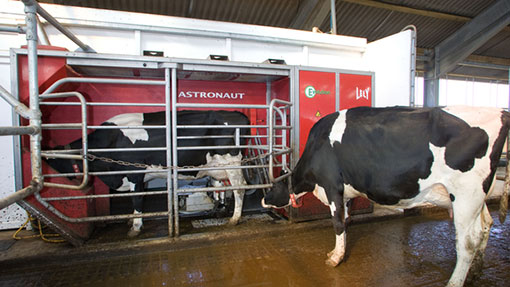Should you invest in a robotic milker?

Lenders are expecting a rise in demand for robotic milking systems, but urge farmers to look on them as part of a long-term business plan and future herd expansion rather than just replacing a parlour.
Dawn Ferris, senior agricultural manager with financiers Lombard, said the company was looking “very positively” at the dairy sector and its financial needs for future development and growth.
She believed the switch to robotic milking would play a major part in expansion plans for an increasing number of dairy farmers.
“For a dairy farmer to get the best out of any financial investment in a robotic milking system, it’s essential to look at the entire farm’s infrastructure and how it can be incorporated to achieve the most benefit, she said.
While some dairy farmers have installed robots into an existing buildings infrastructure, the way cows use robots – either free access or guided flow – means this method of milking has broader implications for cow housing and feeding systems, warned Ivor Davey of Wilson Agriculture.
Unlike conventional parlour milking, robots are being used by cows across a 24-hour period and so become an integral part of their routines and behavioural patterns.
To enable and encourage cows to develop their own effective “lifestyle” of eating, resting and being milked the installation of robot milkers often warrants a re-think of the existing housing lay-out.
Robots now account for half of all milking installations in the UK and the change in the tax rules in the last Budget may result in this increasing further.
“We are lending money to dairy farmers and now the government has increased its annual investment allowance from £250,000 to £500,000, it will hopefully encourage more dairy businesses to invest in expansion,” added Ms Ferris.
“Dairy farmers wanting to invest should have a real foresight for their business and be looking ahead in a proactive way and planning for their family’s future.
Questions to consider before investing
- Big investment – How many do I need? – One robot milks 60 cows
- A different “management mindset” is required when cows are not being seen in the parlour and milked manually
- Cows need to be able to see the robots from any point in their building – can I achieve that?
- Can I milk with a robots and still graze my cows?
“Robotic milking is about far more than just buying a robot, but even if a dairy farmer can’t immediately afford to undertake the changes to the infrastructure, we’d prefer to be involved at the initial stage so we can produce some forecasts and business projections to work towards.”
A straw poll of farmers at a conference organised by dairy consultancy Healthy Cows in Harrogate, North Yorkshire, revealed many were milking fewer than 150 cows, with at least one farmer having already started discussions to finance his first robot.
Mr Davey said that while robots were a big investment they “stacked up” on cost based on their ability to lift yields by at least 15%.
“Based on £100,000 for one robot installed in an 8,000-litre herd, we’re looking at the potential to produce an extra 1,200 litres a cow worth say £360 a cow a year. That’s £21,600 for 60 cows and means a pay-back over four years. And when some robots are giving a 20% increase in yield after the second year it makes these figures look very achievable,” says Mr Davey.
